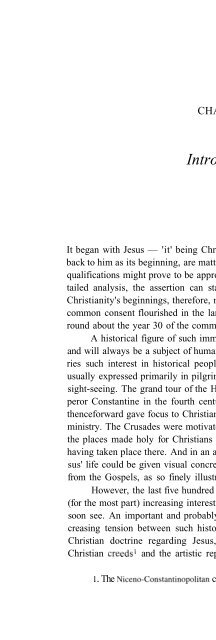Jesus Remembered: Christianity in the Making, vol. 1
Jesus Remembered: Christianity in the Making, vol. 1 Jesus Remembered: Christianity in the Making, vol. 1
CHAPTER 2 Introduction It began with Jesus — 'it' being Christianity. Whether he began it, or it looked back to him as its beginning, are matters to be clarified. Either way, and whatever qualifications might prove to be appropriate or necessary in the light of more detailed analysis, the assertion can stand: it began with Jesus. An inquiry into Christianity's beginnings, therefore, must inevitably start with this Jesus, who by common consent flourished in the land of Israel, otherwise known as Palestine, round about the year 30 of the common era (CE). A historical figure of such immense significance as Jesus has always been and will always be a subject of human curiosity and fascination. In earlier centuries such interest in historical people and events of religious significance was usually expressed primarily in pilgrimage, the ancient equivalent of tourism and sight-seeing. The grand tour of the Holy Land by Queen Helena, mother of Emperor Constantine in the fourth century to identify the sites of Jesus' ministry, thenceforward gave focus to Christian interest in the 'where' of the events of that ministry. The Crusades were motivated by concern to maintain pilgrim access to the places made holy for Christians by what the Christian Gospels recorded as having taken place there. And in an age of widespread illiteracy the details of Jesus' life could be given visual concreteness by artistic reproductions of episodes from the Gospels, as so finely illustrated in the artwork of Chartres Cathedral. However, the last five hundred years of European history have witnessed a (for the most part) increasing interest in the historical figure of Jesus, as we shall soon see. An important and probably unavoidable consequence has been an increasing tension between such historical interest and the traditional claims of Christian doctrine regarding Jesus, classically expressed in the ecumenical Christian creeds 1 and the artistic representations of Christ the Pantocrator (Al- 1. The Niceno-Constantinopolitan creed, known familiarly as the Nicene creed from its 11
- Page 10: CHRISTIANITY IN THE MAKING Volume 1
- Page 14: For Meta my love, my life
- Page 20: CONTENTS 5. The Flight from History
- Page 24: CONTENTS 12.3 Three Key Questions 3
- Page 28: CONTENTS Abbreviations 895 Bibliogr
- Page 32: PREFACE revisions of the lecture ma
- Page 36: PREFACE mediate colleagues, Stephen
- Page 42: CHAPTER 1 Christianity in the Makin
- Page 46: § 1 Christianity in the Making sus
- Page 50: §1 Christianity in the Making Chri
- Page 54: §1 Christianity in the Making figu
- Page 64: FAITH AND THE HISTORICAL JESUS §2
- Page 68: FAITH AND THE HISTORICAL JESUS §2
- Page 72: FAITH AND THE HISTORICAL JESUS §2
- Page 76: FAITH AND THE HISTORICAL JESUS §3.
- Page 80: FAITH AND THE HISTORICAL JESUS §3.
- Page 84: FAITH AND THE HISTORICAL JESUS §3.
- Page 88: FAITH AND THE HISTORICAL JESUS §3.
- Page 92: FAITH AND THE HISTORICAL JESUS §4.
- Page 96: FAITH AND THE HISTORICAL JESUS §4.
- Page 100: FAITH AND THE HISTORICAL JESUS §4.
- Page 104: FAITH AND THE HISTORICAL JESUS §4.
- Page 108: FAITH AND THE HISTORICAL JESUS §4.
CHAPTER 2<br />
Introduction<br />
It began with <strong>Jesus</strong> — 'it' be<strong>in</strong>g <strong>Christianity</strong>. Whe<strong>the</strong>r he began it, or it looked<br />
back to him as its beg<strong>in</strong>n<strong>in</strong>g, are matters to be clarified. Ei<strong>the</strong>r way, and whatever<br />
qualifications might prove to be appropriate or necessary <strong>in</strong> <strong>the</strong> light of more detailed<br />
analysis, <strong>the</strong> assertion can stand: it began with <strong>Jesus</strong>. An <strong>in</strong>quiry <strong>in</strong>to<br />
<strong>Christianity</strong>'s beg<strong>in</strong>n<strong>in</strong>gs, <strong>the</strong>refore, must <strong>in</strong>evitably start with this <strong>Jesus</strong>, who by<br />
common consent flourished <strong>in</strong> <strong>the</strong> land of Israel, o<strong>the</strong>rwise known as Palest<strong>in</strong>e,<br />
round about <strong>the</strong> year 30 of <strong>the</strong> common era (CE).<br />
A historical figure of such immense significance as <strong>Jesus</strong> has always been<br />
and will always be a subject of human curiosity and fasc<strong>in</strong>ation. In earlier centuries<br />
such <strong>in</strong>terest <strong>in</strong> historical people and events of religious significance was<br />
usually expressed primarily <strong>in</strong> pilgrimage, <strong>the</strong> ancient equivalent of tourism and<br />
sight-see<strong>in</strong>g. The grand tour of <strong>the</strong> Holy Land by Queen Helena, mo<strong>the</strong>r of Emperor<br />
Constant<strong>in</strong>e <strong>in</strong> <strong>the</strong> fourth century to identify <strong>the</strong> sites of <strong>Jesus</strong>' m<strong>in</strong>istry,<br />
<strong>the</strong>nceforward gave focus to Christian <strong>in</strong>terest <strong>in</strong> <strong>the</strong> 'where' of <strong>the</strong> events of that<br />
m<strong>in</strong>istry. The Crusades were motivated by concern to ma<strong>in</strong>ta<strong>in</strong> pilgrim access to<br />
<strong>the</strong> places made holy for Christians by what <strong>the</strong> Christian Gospels recorded as<br />
hav<strong>in</strong>g taken place <strong>the</strong>re. And <strong>in</strong> an age of widespread illiteracy <strong>the</strong> details of <strong>Jesus</strong>'<br />
life could be given visual concreteness by artistic reproductions of episodes<br />
from <strong>the</strong> Gospels, as so f<strong>in</strong>ely illustrated <strong>in</strong> <strong>the</strong> artwork of Chartres Ca<strong>the</strong>dral.<br />
However, <strong>the</strong> last five hundred years of European history have witnessed a<br />
(for <strong>the</strong> most part) <strong>in</strong>creas<strong>in</strong>g <strong>in</strong>terest <strong>in</strong> <strong>the</strong> historical figure of <strong>Jesus</strong>, as we shall<br />
soon see. An important and probably unavoidable consequence has been an <strong>in</strong>creas<strong>in</strong>g<br />
tension between such historical <strong>in</strong>terest and <strong>the</strong> traditional claims of<br />
Christian doctr<strong>in</strong>e regard<strong>in</strong>g <strong>Jesus</strong>, classically expressed <strong>in</strong> <strong>the</strong> ecumenical<br />
Christian creeds 1 and <strong>the</strong> artistic representations of Christ <strong>the</strong> Pantocrator (Al-<br />
1. The Niceno-Constant<strong>in</strong>opolitan creed, known familiarly as <strong>the</strong> Nicene creed from its<br />
11



